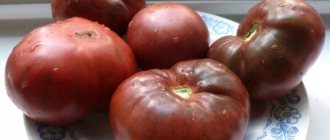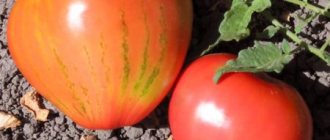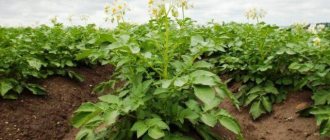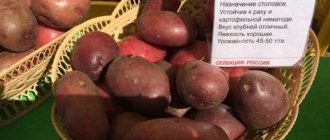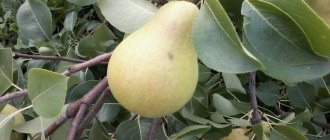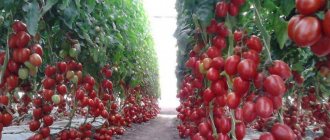Tomato “Apples in the Snow”: description of the variety
| Variety name | Apples in the snow |
| general description | An early-ripening, determinate variety of tomatoes for growing in greenhouses and open ground. |
| Originator | Russia |
| Ripening period | 90-100 days |
| Form | Round, slightly flattened, without pronounced ribbing |
| Color | Red |
| Average weight of tomatoes | 50-70 grams |
| Application | Tableware, for canning |
| Productivity of the variety | 2 kg per bush |
| Features of cultivation | Standard agricultural technology |
| Disease resistance | Resistant to major tomato diseases |
Tomatoes Apples on the Snow are an early-ripening, very productive variety.
The bush is determinate, compact, with a moderate amount of green mass. Read about indeterminate varieties here. The height of the plant is no more than 70 cm. The leaves are small, dark green. For greater yield, it is recommended to form a bush using light pinching. The fruits ripen in clusters of 5-7 pieces. During fruiting, the plant looks very elegant. From one bush you can collect 30-35 selected tomatoes .
You can see the yields of other varieties in the table below:
| Variety name | Productivity |
| Apples in the snow | 2.5-3 kg per bush |
| Lazy | 15 kg per square meter |
| Summer resident | 4 kg per bush |
| Doll | 8-9 kg per square meter |
| Fat Jack | 5-6 kg per bush |
| Andromeda | 12-20 kg per square meter |
| Honey Heart | 8.5 kg per square meter |
| Pink Lady | 25 kg per square meter |
| Lady Shady | 7.5 kg per square meter |
| Gulliver | 7 kg per square meter |
| Bella Rosa | 5-7 kg per square meter |
The fruits are small, even, weighing 50-70 g. The shape is round, slightly flattened, without pronounced ribbing or spots on the stalks. The skin is thin but dense, well protecting the tomatoes from cracking. Ripe fruits have a bright red color. The pulp is dense and juicy, there are many seed chambers. The taste is pleasant, sweet, with barely noticeable sourness.
You can compare the weight of fruits with other varieties of tomatoes in the table below:
| Variety name | Fruit weight |
| Apples in the snow | 50-70 grams |
| Bobcat | 180-240 grams |
| Russian size | 650 grams |
| King of Kings | 300-1500 grams |
| Long Keeper | 125-250 grams |
| Grandma's gift | 180-220 grams |
| Brown sugar | 120-150 grams |
| Rocket | 50-60 grams |
| Altaic | 50-300 grams |
| Yusupovsky | 500-600 grams |
| De Barao | 70-90 grams |
Description
This is a determinate, very compact plant. The height of the bush is no more than 50 cm. The strong trunk is moderately covered with small dark green leaves. The tomatoes are small, round, bright red. During the fruiting period, the bush looks very decorative. Therefore, many people grow “Apple Tree in the Snow” not only in the country, but also in flowerpots on the balcony.
When planting seeds for seedlings in early March, the first tomatoes ripen at the end of June. They are formed with brushes from 5 to 7 pieces on each. With good care, you can harvest up to 2.5 kg of harvest from one bush. The variety is universal in use. Suitable for preparations - juices, purees, preservation. And for fresh consumption.
Origin and application
The Russian tomato variety Apples on the Snow was bred by amateur breeders and is intended for cultivation in greenhouses, greenhouses, under film, and in open ground.
Compact bushes can be planted in large pots for placement on verandas, loggias, and glazed balconies. Despite their miniature size, tomatoes have good yields. Harvested tomatoes are stored well.
Small fruits with thin but strong skin are excellent for canning. They can be included in assorted vegetables, used for salads, side dishes, and to decorate dishes. Small bright red tomatoes Children love apples in the snow.
How to grow an Apple tomato. Recommendations
Tomatoes are grown by seedlings, they love fertile soils and can be grown in any region of the country
It is important not to forget that before planting, disinfect the seeds in a solution of potassium permanganate and then rinse with clean water
During seedling growth, it should be fed three times with complex fertilizers. At the stage of two or three permanent leaves, Apple seedlings dive.
Apple tomato on the bush
A week before planting seedlings in the ground, they must be hardened off. It is planted in a permanent place of growth at the age of two to two and a half months. Planting pattern between tomato bushes 70x30-40 cm.
The plants are tall and require staking and formation into one stem for good fruiting. Water with warm water and regularly feed with complex fertilizers. Proper care will provide gardeners with a rich tomato harvest.
The fruits, unusual in their color, have an amazing delicious taste and high content of nutrients, were bred by Russian breeders. The color of the Emerald Apple tomato is rich green with a bronze tint. The bush is indeterminate, tall, well-leafed, needs shaping. 3 or 4 ovaries are formed on one flower brush. An adult and mature bush can produce up to 10 kg of tomato. The harvest takes place in July - September. The tomatoes are large, weighing up to 300 g. The shape is round with slightly noticeable ribbing. The pulp is dense, juicy, unusual emerald color, fleshy, very pleasant, sweet, with notes of sourness, somewhat reminiscent of the taste of ripe actinidia. The amount of sugars and beneficial amino acids is higher than that of any variety of tomatoes. Tomatoes are recommended by doctors for dietary and baby food. The Emerald Apple tomato is one of the tastiest and most aromatic varieties of green tomatoes, ideal for slicing into sandwiches and as a base for delicious purees.
Tomato Emerald apple
Characteristics
- Designed for open ground and greenhouses.
- Suitable for preservation and fresh consumption.
- The juice is lemon-greenish in color, with an excellent specific aroma, slightly spicy, with slightly noticeable citrus notes and kiwi flavor.
- Delicious fresh, pickled and salted.
- Tomato (nightshade crops) is resistant to major diseases.
- Good storage properties.
- It is necessary to form the shape of the bush.
- Requires nutritious soil.
Growing and its features
For seedlings, Emerald Apple seeds are sown in late March or early April. Before sowing, the seeds are soaked for 12 hours in a growth stimulator.
Tomato loves soil with neutral acidity, light, nutritious. The ideal soil composition for seedlings is: turf soil with humus in a 1:1 ratio, you can add a little river sand and vermiculite. Before planting, it is recommended to calcine the soil for sowing in the oven; in the greenhouse, water the soil with a hot solution of potassium permanganate. The seeds are buried 1.5 cm into the soil. After sowing, the soil is sprayed with a spray bottle. As soon as the first shoots hatch, the trays and containers with the seedlings are exposed to sunlight. On cloudy and stormy days, it is recommended to artificially illuminate the room where the seedlings are located.
Tomato Emerald apple on a bush
As soon as the first two true leaves appear, the seedlings are planted in separate pots of peat mixture and fed with complex fertilizer.
After the soil has completely warmed up, the seedlings have grown stronger and grown, they are transplanted to a permanent place. The distance between rows is 60-70 cm, between plants - 50 cm. For the first days in open ground, it is recommended to cover the seedlings with film, then remove it. Watering is not frequent (only when the top layer of soil dries), but abundant and only with warm water. Weeding and loosening of the soil is required.
The plant is immediately provided with support and tied to it, the lower leaves and side shoots are removed, forming one or two main stems. If you don't plant the plants, they will quickly thicken and begin to resemble a tropical forest.
The harvest is harvested in late August and early September.
Advantages and disadvantages
Among the main advantages of the variety:
- very early ripening, the first tomatoes are harvested at the end of June;
- delicious small fruits that children love;
- excellent yield;
- resistance to major nightshade diseases.
The variety has practically no disadvantages . The only problem may be susceptibility to late blight.
Fruits and harvest
To increase the yield of the crop, pinching is carried out, thereby forming a bush. Simultaneous ripening of fruits occurs on one bunch. There can be from 4 to 8 pieces on a branch. At the time of fruiting, the plant looks beautiful. 50 pieces are collected from one bush, with most of them being selected - from 30 to 37 pieces.
The weight of the fruit does not exceed 70 g. They are small, they have a round shape, slightly flattened in the area of the stalk. There are no spots or excessive ribbing near the stem. The skin covering the pulp is thin. At the same time, it has good density and prevents tomatoes from cracking from excessive moisture in the form of precipitation.
Description and characteristics of the tomato variety Marfa F1Read
When tomatoes ripen, they have rich red flesh. It is dense, but remains juicy. Despite its small size, there are many chambers inside the tomato. Sweetish, light and pleasant taste has subtle sour notes.
Photo
See below: tomatoes Apples in the snow photo
Tomato Siberian apple
photo author Yuri Kholyavko
Mid-season, indeterminate (with unlimited growth), productive tomato variety. Recommended for growing in the middle zone in greenhouses, and in the southern regions in open ground. The period from germination to the beginning of ripening is on average 115 days.
The height of the bush is 1.5-1.8 meters; it requires tying to a support and pinching. The greatest yield was obtained when the plant was formed into 2 stems.
Basic qualities of fruits
The fruits are round, dense, smooth, pearl pink in color at maturity, weighing up to 200 grams, excellent taste. These tomatoes are fleshy, sugary when broken, and retain their commercial quality for a long time on the plant and during storage. Suitable for fresh consumption, canning, making juices and sauces.
photo author Lyudmila Golubeva
The photo shows Siberian Apple tomato seedlings.
Features of cultivation, planting and care
We recommend sowing the seeds of this variety of tomatoes for seedlings 60-65 days before the intended planting in a permanent place. Seedlings dive at the stage of two true leaves. When planting seedlings in a permanent place per 1 sq. Place up to 4 plants per meter of plot.
Further care for tomatoes consists of timely watering, fertilizing with complex mineral fertilizer, pinching and preventive measures to protect against diseases and pests.
When growing tomatoes in a greenhouse, we recommend installing a drip irrigation system - this will save your time and effort, as well as increase plant productivity and reduce the risk of late blight.
Tomatoes Siberian apple on video
If you grew Siberian Apple tomatoes, please write whether you liked them or not. What was the yield and taste of the fruits like under your climatic conditions? Briefly describe the advantages and disadvantages of this tomato in your opinion. If possible, attach a photo of these tomatoes to your comment. Thank you!
Your reviews of the Siberian Apple tomato and additions to the description will help many tomato lovers evaluate this variety more objectively and decide whether it is worth planting or not.
Features of cultivation
Tomatoes variety Apples on the Snow are sown as seedlings in the first half of March. It is better to treat the seeds with a growth stimulant, which significantly improves germination.
Plants need lightweight, highly nutritious soil, consisting of a mixture of garden soil and humus. Seeds are sown in containers with a depth of 2 cm, sprayed with water and covered with film. You can use special mini-greenhouses. After germination, the containers are exposed to bright light. Plantings should be watered with warm, settled water, using a shallow watering can or spray bottle.
When the first pair of true leaves unfold, the plants dive into separate pots. Then the tomatoes are fed with complex fertilizer. It is recommended to feed weak shoots with nitrogen-containing preparations (for example, urea).
Planting in a permanent place, in a greenhouse or pots, is carried out in the first half of May. Tomatoes are moved to open beds closer to June, when the soil has completely warmed up. For 1 sq. m you can place no more than 4 bushes. Too many rows prevent tomatoes from developing and fruiting slows down.
During the season, plants are fed 3-4 times with mineral fertilizers based on phosphorus and potassium. The bush is slightly pinched; the lower leaves can also be removed.
Read in detail everything about tomato fertilizers:
- Organic, ready-made complexes, TOP of the best.
- Yeast, iodine, ash, hydrogen peroxide, ammonia, boric acid.
- Foliar, for seedlings, for picking.
Growing tomatoes in the country
Before planting tomatoes in open ground, sowing and growing seedlings indoors is carried out. For better germination, the seeds are pre-soaked in salt water.
The soil chosen is loose and nutritious. A mixture of leaf soil and humus is used as soil. Seeds are planted in containers, immersed to a depth of 1.5-2 cm. Germination is carried out at a temperature of 22-24°C.
To create optimal conditions, the container is covered with film. Experienced vegetable growers recommend treatment with a growth stimulant to speed up the emergence of seedlings.
The container with the sprouts is placed in a well-lit place and regularly sprayed with heated water. After several leaves appear, the seedlings can be planted in different pots. Ready-made complex fertilizers will not interfere.
In the first days of May, seedlings can be planted in greenhouses. Plants are moved to open ground when the threat of night frosts has passed. As a rule, this occurs no earlier than the end of May.
The bushes are not planted tightly. With a small distance between tomatoes, the growth and ripening of the crop slows down.
Be responsible when choosing a landing site. It is undesirable to plant tomatoes in the same area for two years in a row.
They also choose their neighbors carefully. Gardeners do not recommend placing tomatoes near potatoes or eggplants. A combination of carrots, onions, beans or pumpkin is suitable.
Diseases and pests
Apples in the snow is a tomato variety that is quite resistant to viral diseases, for example, tobacco mosaic. However, it may be susceptible to late blight. For prevention, it is recommended to pull out weeds in a timely manner and ventilate the greenhouse.
The soil can be mulched with peat or straw. Plants are sprayed with copper-containing preparations, the affected leaves and fruits are promptly destroyed and then burned.
How to care for bushes
In order for tomatoes to produce a good harvest, they should be looked after. Please note the following content items:
Watering
Please note that watering young plants for the first couple of weeks after planting is not recommended. First, the bushes must be firmly rooted. Be careful about watering during the period of fruit formation and ripening. Do not allow the soil to dry out.
The soil
Plants need slightly acidic or neutral soil. In case of increased acidity, additional lime is added to the soil.
Loosening and weeding
It is important that the soil is loose. Loosening will help retain moisture and provide access to oxygen. Don't neglect this element of care. Get rid of weeds from plants in a timely manner.
Fertilizers
Tomato responds well to fertilizing. At the active growth stage, nitrogen fertilizers are needed to stimulate the development of greenery.
During the flowering period, products containing phosphorus and potassium are used. These elements contribute to the rapid formation of ovaries and fruit growth.
Garter and stepson
Apples in the snow do not have to be tied up or pinched. Procedures are carried out at the request of the owner.
Prevention
Since the variety is susceptible to the development of late blight, it is necessary to pay attention to prevention. Weed out weeds in a timely manner and ventilate greenhouses properly. Mulching the soil with peat has a good effect.
Avoid overfeeding with fertilizers. Periodically treat the bush with special products (Ridomil). If the plant is affected by a disease, it will have to be removed.
Useful video
Watch the video: how to deal with late blight
And in the table below you will find links to articles about tomatoes of various ripening periods that may be useful to you:
| Super early | Mid-season | Mid-early |
| White filling | Black Moor | Khlynovsky F1 |
| Moscow stars | Tsar Peter | One hundred poods |
| Room surprise | Alpatieva 905 a | Orange Giant |
| Aurora F1 | Favorite F1 | Sugar Giant |
| Severenok F1 | La La Fa F1 | Rosaliza F1 |
| Katyusha | Right size | Em Champion |
| Labrador | Dimensionless | Sultan F1 |
Tomato variety Apple
Russian breeders developed the apple tomato variety for a reason. The goal of the experiment was to create tomatoes that can be stored for a maximum amount of time, are easy to transport, universal in processing and consumption, with incredible taste, which will be sold in a large assortment according to the color of the fruit. In general, all apple variety tomatoes have the same description.
They:
- Medium early in maturity;
- High-yielding;
- Indeterminate;
- Can grow up to 1.5m;
- Have high power;
- Must be formed during cultivation.
Quite a lot of gardeners grow Apple tomatoes, since they are versatile in processing and have a long shelf life.
The fruits grow mainly in clusters of 7 pieces each. As a rule, an adult bush can produce up to 10 kg of yield. Harvest from July to September.
Fruit:
- Large size;
- They have many cameras;
- Weight reaches up to 300g;
- Flat-rounded;
- Slightly ribbed.
Ripe tomatoes are somewhat reminiscent of deep green apples with a lemon tint, especially if they are the Golden Apples variety or the Green Siberian apple hybrid.
In addition, they have juicy, dense emerald green flesh. As for the composition, apple tomatoes contain sugar and beneficial amino acids. They can be great for dietary and even baby food.
Characteristics of the apple series
Among the tomatoes that have gained popularity among vegetable growers is the Apple tomato and its varieties. The versatile fruits have a pleasant taste and can be stored for a long time.
Anyone who planted Apple Tomato notes the average early ripening period, the universal purpose of the product. Tomato Apples on the snow belongs to the determinant type.
On a bush 60 cm high, up to 35 fruits weighing 50 g ripen. Up to 3 kg of tomatoes are harvested from the plant, which are distinguished by their uniform color and long shelf life. Medium-sized tomatoes have a height of up to 1 m. These include Malinovka Apple, with raspberry-colored fruits.
The yield per bush reaches 5 kg. The Apple Spas variety is resistant to diseases of nightshade crops. The fruits are universally used and can be transported over distances.
Description of the Tolstoy Monk tomato, growing rules and plant care
Read
The Golden Apple tomato is suitable for cultivation in various conditions. The fruits are yellow, round in shape, hidden under the bright green leaves. Tomatoes of the Emerald Apple variety at the ripe stage have an intense green color.
Paradise Apple and Cherry tomatoes are small-fruited varieties of tomatoes. The new tomato-apple hybrid Red Love is a fruit tree. The flower stalks are shaped like apple trees, and ripe fruits have the appearance of a tomato.
Tomato Superpriz F1
- Al Mar knives, USA
- Knives Antonini, Italy
- Bark River knives, USA
- Benchmade knives, USA
- Bestech knives, China
- Boker knives, Germany
- Buck knives, USA
- Knives Citadel, Cambodia
- Cold Steel knives, USA
- Condor knives, USA
- CRKT knives, USA
- Emerson knives, USA
- Enlan knives, China
- Knives Fallkniven, Sweden
- Forever knives, Japan
- Fox knives, Italy
- Ganzo knives, China
- Gerber knives, USA
- G.Sakai knives, Japan
- Hatamoto knives, Japan
- Hattori knives, Japan
- Knives Higonokami (Nagao), Japan
- Hiroo Itou knives, Japan
- Hogue knives, USA
- Knives IC.CUT, Japan
- Knives Jero, Portugal
- Joker knives, Spain
- Kanetsugu knives, Japan
- Kasumi knives, Japan
- Katz knives, USA
- Kershaw knives, USA
- Kizlyar Supreme knives, Russia
- Knives Light my Fire, Sweden
- Knives MAM, Portugal
- Masahiro knives, Japan
- Mcusta knives, Japan
- Microtech knives, USA
- Knives Morakniv (Mora), Sweden
- Knives Ontario, USA
- Opinel knives, France
- Knives Real Steel, China
- Reptilian knives, China
- Ruike knives, China
- Sakai Takayuki knives, Japan
- Samura kitchen knives
- Satake knives, Japan
- SOG knives, USA
- Steelclaw knives, China
- Tojiro knives, Japan
- Victorinox knives, Switzerland
- Viking Nordway knives, Russia
- Zero Tolerance knives, USA
- Knives A&R (Zlatoust), Russia
- Knives Kizlyar, Russia
- Kizlyar knives
- Knives Lebezh, Russia
- Knives NOKS, Russia
- Knives Pashikhin, Russia
- Knives Fursach (Vorsma), Russia
- Yakut knives Shilin, Russia
- Knives Southern Cross, Russia
- Knives Yasny Sokol, Russia
- Officer's daggers
- Kukri from Nepal
- Machete
- Folding knives
- Folding knives
- Knives of Russia
- Swiss knives
- Chinese knives
- Japanese knives
- Handmade knives
- Karambit knives
- Knives Pchak
- Tanto knives
- Fink knives
- Yakut knives
- Throwing knives
- Tactical knives
- Knife workshop
cekatop.ru




